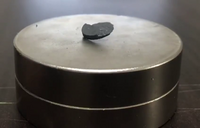
Photo from wikipedia
Levitation offers extreme isolation of mechanical systems from their environment, while enabling unconstrained high‐precision translation and rotation of objects. Diamagnetic levitation is one of the most attractive levitation schemes because… Click to show full abstract
Levitation offers extreme isolation of mechanical systems from their environment, while enabling unconstrained high‐precision translation and rotation of objects. Diamagnetic levitation is one of the most attractive levitation schemes because it allows stable levitation at room temperature without the need for a continuous power supply. However, dissipation by eddy currents in conventional diamagnetic materials significantly limits the application potential of diamagnetically levitating systems. Here, a route toward high‐Q macroscopic levitating resonators by substantially reducing eddy current damping using graphite particle based diamagnetic composites is presented. Resonators that feature quality factors Q above 450 000 and vibration lifetimes beyond one hour are demonstrated, while levitating above permanent magnets in high vacuum at room temperature. The composite resonators have a Q that is >400 times higher than that of diamagnetic graphite plates. By tuning the composite particle size and density, the dissipation reduction mechanism is investigated, and the Q of the levitating resonators is enhanced. Since their estimated acceleration noise is as low as some of the best superconducting levitating accelerometers at cryogenic temperatures, the high Q and large mass of the presented composite resonators positions them as one of the most promising technologies for next generation ultra‐sensitive room temperature accelerometers.
Journal Title: Advanced Science
Year Published: 2022
Link to full text (if available)
Share on Social Media: Sign Up to like & get
recommendations!